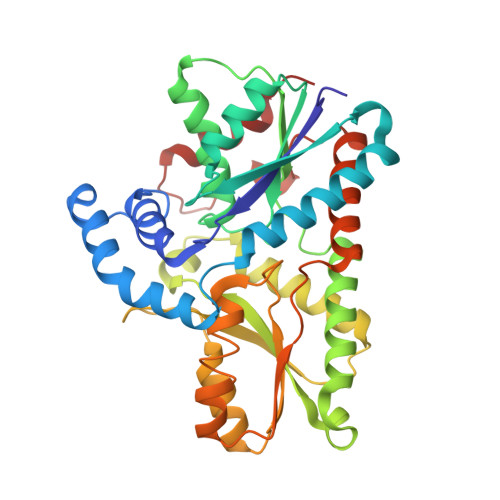Altered orientation of active site residues in variants of human ferrochelatase. Evidence for a hydrogen bond network involved in catalysis.
Dailey, H.A., Wu, C.K., Horanyi, P., Medlock, A.E., Najahi-Missaoui, W., Burden, A.E., Dailey, T.A., Rose, J.(2007) Biochemistry 46: 7973-7979
- PubMed: 17567154
- DOI: https://doi.org/10.1021/bi700151f
- Primary Citation of Related Structures:
2PNJ, 2PO5, 2PO7 - PubMed Abstract:
Ferrochelatase catalyzes the terminal step in heme biosynthesis, the insertion of ferrous iron into protoporphyrin to form protoheme IX. The crystal structures of human ferrochelatase both with and without the protoporphyrin substrate bound have been determined previously. The substrate-free enzyme has an open active site pocket, while in the substrate-bound enzyme, the active site pocket is closed around the porphyrin macrocycle and a number of active site residues have reoriented side chains. To understand how and why these structural changes occur, we have substituted three amino acid residues (H263, H341, and F337) whose side chains occupy different spatial positions in the substrate-free versus substrate-bound ferrochelatases. The catalytic and structural properties of ferrochelatases containing the amino acid substitutions H263C, H341C, and F337A were examined. It was found that in the H263C and H341C variants, but not the F337A variant enzymes, the side chains of N75, M76, R164, H263, F337, H341, and E343 are oriented in a fashion similar to what is found in ferrochelatase with the bound porphyrin substrate. However, all of the variant forms possess open active site pockets which are found in the structure of porphyrin-free ferrochelatase. Thus, while the interior walls of the active site pocket are remodeled in these variants, the exterior lips remain unaltered in position. One possible explanation for this collective reorganization of active site side chains is the presence of a hydrogen bond network among H263, H341, and E343. This network is disrupted in the variants by alteration of H263C or H341C. In the substrate-bound enzyme, the formation of a hydrogen bond between H263 and a pyrrole nitrogen results in disruption of the network. The possible role of this network in catalysis is discussed.
Organizational Affiliation:
Biomedical and Health Sciences Institute, Department of Microbiology, Paul D. Coverdell Center, University of Georgia, Athens, Georgia 30602, USA. hdailey@uga.edu
















